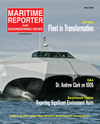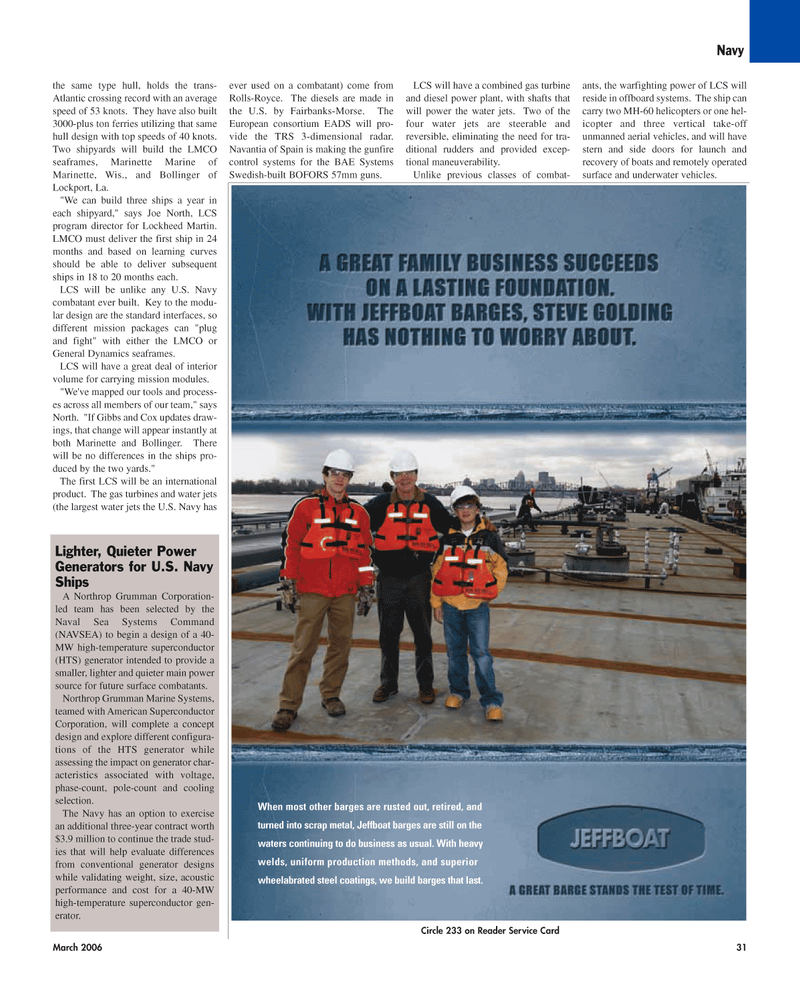
Page 31: of Maritime Reporter Magazine (March 2006)
The Training & Education Edition
Read this page in Pdf, Flash or Html5 edition of March 2006 Maritime Reporter Magazine
the same type hull, holds the trans-
Atlantic crossing record with an average speed of 53 knots. They have also built 3000-plus ton ferries utilizing that same hull design with top speeds of 40 knots.
Two shipyards will build the LMCO seaframes, Marinette Marine of
Marinette, Wis., and Bollinger of
Lockport, La. "We can build three ships a year in each shipyard," says Joe North, LCS program director for Lockheed Martin.
LMCO must deliver the first ship in 24 months and based on learning curves should be able to deliver subsequent ships in 18 to 20 months each.
LCS will be unlike any U.S. Navy combatant ever built. Key to the modu- lar design are the standard interfaces, so different mission packages can "plug and fight" with either the LMCO or
General Dynamics seaframes.
LCS will have a great deal of interior volume for carrying mission modules. "We've mapped our tools and process- es across all members of our team," says
North. "If Gibbs and Cox updates draw- ings, that change will appear instantly at both Marinette and Bollinger. There will be no differences in the ships pro- duced by the two yards."
The first LCS will be an international product. The gas turbines and water jets (the largest water jets the U.S. Navy has ever used on a combatant) come from
Rolls-Royce. The diesels are made in the U.S. by Fairbanks-Morse. The
European consortium EADS will pro- vide the TRS 3-dimensional radar.
Navantia of Spain is making the gunfire control systems for the BAE Systems
Swedish-built BOFORS 57mm guns.
LCS will have a combined gas turbine and diesel power plant, with shafts that will power the water jets. Two of the four water jets are steerable and reversible, eliminating the need for tra- ditional rudders and provided excep- tional maneuverability.
Unlike previous classes of combat- ants, the warfighting power of LCS will reside in offboard systems. The ship can carry two MH-60 helicopters or one hel- icopter and three vertical take-off unmanned aerial vehicles, and will have stern and side doors for launch and recovery of boats and remotely operated surface and underwater vehicles.
March 2006 31
Circle 233 on Reader Service Card
When most other barges are rusted out, retired, and turned into scrap metal, Jeffboat barges are still on the waters continuing to do business as usual. With heavy welds, uniform production methods, and superior wheelabrated steel coatings, we build barges that last.
Navy
Lighter, Quieter Power
Generators for U.S. Navy
Ships
A Northrop Grumman Corporation- led team has been selected by the
Naval Sea Systems Command (NAVSEA) to begin a design of a 40-
MW high-temperature superconductor (HTS) generator intended to provide a smaller, lighter and quieter main power source for future surface combatants.
Northrop Grumman Marine Systems, teamed with American Superconductor
Corporation, will complete a concept design and explore different configura- tions of the HTS generator while assessing the impact on generator char- acteristics associated with voltage, phase-count, pole-count and cooling selection.
The Navy has an option to exercise an additional three-year contract worth $3.9 million to continue the trade stud- ies that will help evaluate differences from conventional generator designs while validating weight, size, acoustic performance and cost for a 40-MW high-temperature superconductor gen- erator.
MR MARCH2006 #4 (25-32).qxd 3/2/2006 11:44 AM Page 31

 30
30

 32
32
